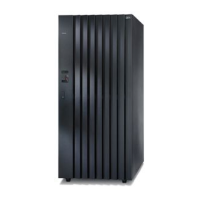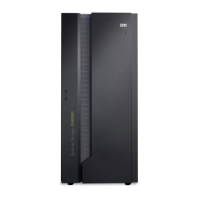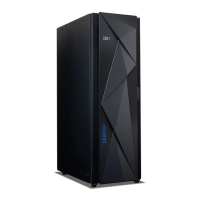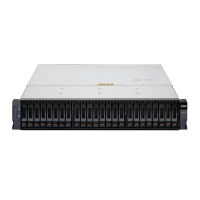v Only define the actual base and alias devices to IOCP or HCD to avoid
unnecessary definition of processor subchannels.
v Only define the unit address range to IOCP or HCD as necessary for the
installed devices in an LCU (64, 128, or 256). Defining the unit address range
enables you to put more LCUs and devices on a channel path.
IBM
recommends that you document the configuration you define for the DS8000.
With the exception of the 3380 and 3390 models, the DS8000 configuration and the
IOCP input must match.
Note: The CU device is a 2107/242x for any DS8000 device type. In HCD you can
use 3990 as a control-unit type for 3380 and 3390 devices. However, you
must use 2107/242x as the control-unit type for 3380B, 3380A, 3390B, and
3390A devices.
Reconfiguring an LCU with larger capacity 3390 volumes
Complete this task to reconfigure an LCU with larger capacity 3390 volumes.
To retain your data, you must offload the data from the address range of the ranks
to be reformatted by performing the following steps:
1. Confirm the raid ranks that are associated with the address range that is being
modified.
2. Vary the address range offline. This causes any associated parallel access
volumes (PAVs) to become unbound.
3. Issue Devserv (DS QP,xxxx,nnnn) using the alias addresses to confirm aliases
are unbound.
4. Undefine the raid rank to allow the configuration of larger capacity volumes.
5. Reassociate the PAVs.
6. Vary the base address range online.
7. Issue Devserv (DS QP,xxxx,nnnn) using the base addresses to confirm that the
aliases are bound.
8. Restore the data that you offloaded.
Increasing the number of 3390s formatted within an LCU
Complete this task to increase the number of 3390s that are formatted within an
LCU.
To increase the number of 3390s that are formatted within an LCU, perform the
following:
1. Define an input/output definition file (IODF) using HCD with the desired
device addresses.
2. Remove the parallel access volumes (PAVs) using the DS8000 CLI.
3. Issue Devserv (DS QP,xxxx,nnnn) to the alias addresses to initiate an I/O
operation.
Note: Messages ″IOS017I ALIAS DEVICE adev IS UNBOUND″ and ″IOS001E
xxxx, INOPERATIVE PATH″ are issued from all the alias addresses.
These messages are normal and are not cause for concern.
4. Activate a new IODF by either performing an IPL or by dynamically activating
the new IODF.
106 DS8000 User’s Guide
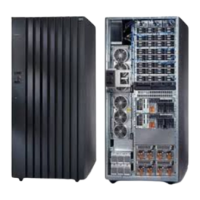
